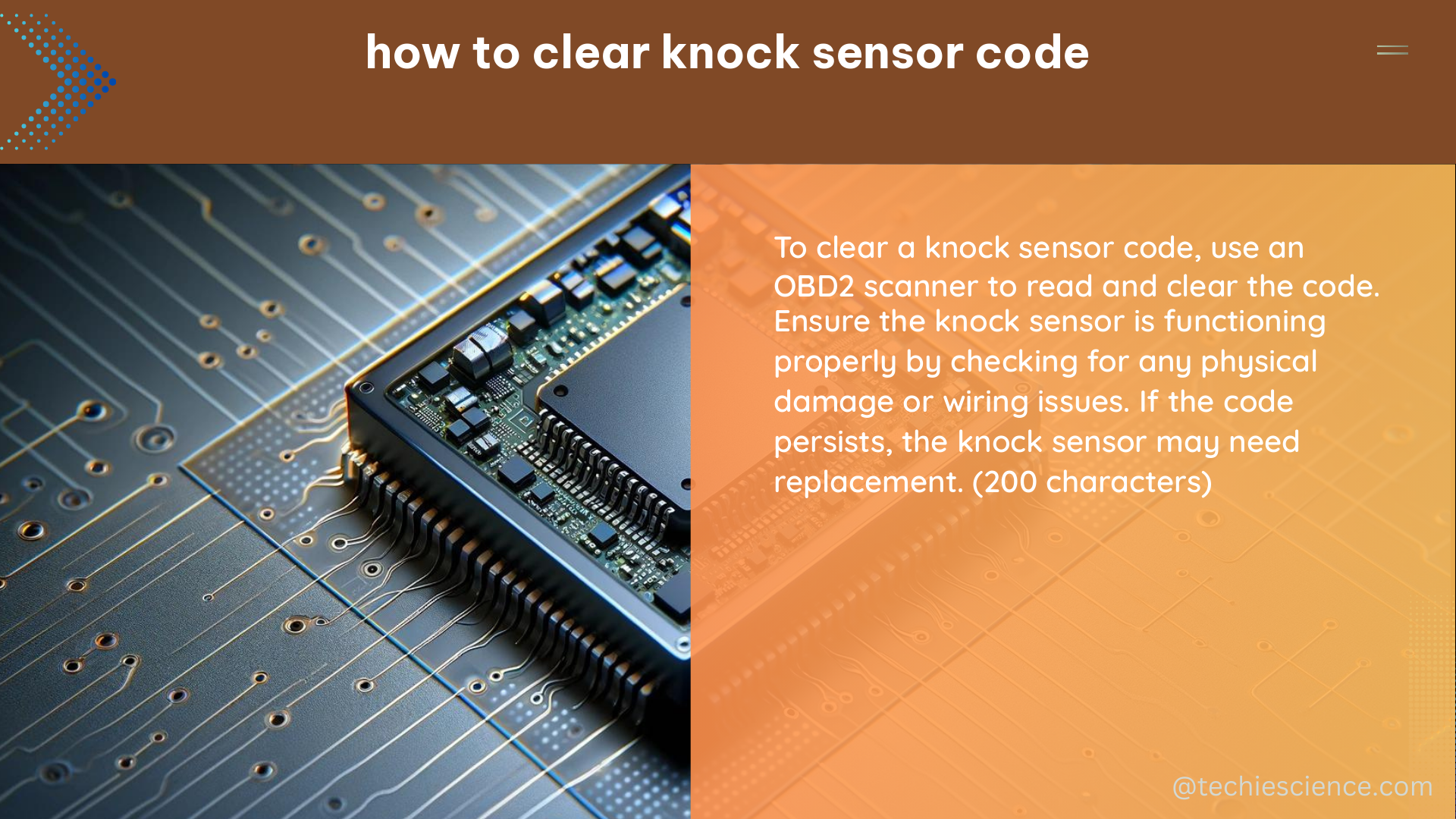Clearing a knock sensor code is a crucial step in maintaining the health and performance of your vehicle’s engine. The knock sensor, a vital component of the engine management system, detects engine knocking or pinging, which can lead to severe engine damage if left unaddressed. This comprehensive guide will walk you through the process of diagnosing and resolving the underlying issue, as well as the step-by-step instructions for clearing the knock sensor code using a diagnostic tool.
Diagnosing the Knock Sensor Code
The first step in clearing a knock sensor code is to diagnose the problem. This involves using a diagnostic tool, such as an OBD-II scanner, to read the codes from the engine control unit (ECU). The code will provide valuable information, including the specific cylinder(s) experiencing knocking and the severity of the issue.
Identifying the Cause of Engine Knocking
Once you have the diagnostic code, you can begin to investigate the underlying cause of the engine knocking. Some common causes include:
-
Improper Fuel Octane Level: Using fuel with an octane rating that is too low for your vehicle can cause the air-fuel mixture to detonate prematurely, resulting in knocking. Check your vehicle’s owner’s manual to determine the recommended octane rating and ensure you are using the correct fuel.
-
Incorrect Ignition Timing: If the ignition timing is off, the spark plugs may fire at the wrong time, causing the air-fuel mixture to detonate improperly. This can be caused by worn or faulty spark plugs, a malfunctioning distributor, or a faulty camshaft position sensor.
-
Mechanical Issues: In some cases, engine knocking can be caused by mechanical problems, such as worn piston rings, a damaged crankshaft, or a malfunctioning turbocharger.
Diagnostic Tools and Techniques
To diagnose the cause of the engine knocking, you may need to use a variety of diagnostic tools and techniques, including:
- OBD-II Scanner: This tool can read and clear the knock sensor code, as well as provide additional information about the engine’s performance.
- Compression Test: A compression test can help identify any issues with the engine’s internal components, such as worn piston rings or a damaged cylinder.
- Spark Plug Inspection: Examining the spark plugs can reveal signs of improper ignition timing or other issues.
- Fuel Pressure and Flow Test: Checking the fuel pressure and flow can help determine if the fuel system is functioning correctly.
Clearing the Knock Sensor Code

Once you have identified and addressed the underlying cause of the engine knocking, you can use a diagnostic tool to clear the knock sensor code. The process for doing this will vary depending on the tool you are using, so be sure to consult the manufacturer’s instructions.
Step-by-Step Instructions
- Connect the Diagnostic Tool: Use an OBD-II scanner or other diagnostic tool to connect to your vehicle’s ECU.
- Read the Knock Sensor Code: The tool will display the knock sensor code(s) that are currently stored in the ECU.
- Identify the Cause: Refer to the diagnostic information you gathered earlier to determine the cause of the engine knocking.
- Address the Underlying Issue: Take the necessary steps to fix the underlying problem, such as replacing the spark plugs, adjusting the ignition timing, or using the recommended fuel octane.
- Clear the Code: Once the underlying issue has been addressed, use the diagnostic tool to clear the knock sensor code(s) from the ECU.
- Verify the Repair: Take the vehicle for a test drive to ensure that the engine is running smoothly and that the knock sensor code(s) do not return.
Replacement of the Knock Sensor
In some cases, it may be necessary to replace the knock sensor itself. This is typically a straightforward process that involves removing the old sensor and installing a new one. Be sure to use a high-quality replacement sensor and follow the instructions provided by the manufacturer to ensure proper installation.
Technical Specifications for Clearing a Knock Sensor Code
To effectively clear a knock sensor code, you will need the following:
- Diagnostic Tool: An OBD-II scanner or other diagnostic tool with the capability to read and clear knock sensor codes.
- Replacement Knock Sensor: If the knock sensor needs to be replaced, ensure that you have a compatible, high-quality replacement sensor.
- Knowledge of Vehicle Specifications: Familiarize yourself with your vehicle’s recommended fuel octane rating and ignition timing specifications, as these will be crucial in diagnosing and addressing the underlying issue.
- Manufacturer Instructions: Follow the instructions provided by the diagnostic tool manufacturer for the specific process of clearing knock sensor codes.
Conclusion
Clearing a knock sensor code is a critical step in maintaining the health and performance of your vehicle’s engine. By following the comprehensive guide outlined in this article, you can effectively diagnose the underlying cause, address the issue, and clear the code using a diagnostic tool. Remember to always use high-quality replacement parts and follow the manufacturer’s instructions to ensure a successful repair.
References:
– Major Accident Prevention Policy and Safety Management Systems. (n.d.). WorkSafe New Zealand. Retrieved May 10, 2024, from https://www.worksafe.govt.nz/dmsdocument/71-mhf-major-accident-prevention-policy-and-safety-management-systems
– Check and change ABS and wheel speed sensors. (n.d.). HELLA. Retrieved May 10, 2024, from https://www.hella.com/techworld/us/Technical/Sensors-and-actuators/Check-change-ABS-sensor-4074/
– I got in trouble for using a mouse jiggler … despite my excellent work. (2023, January 10). Ask a Manager. Retrieved May 10, 2024, from https://www.askamanager.org/2023/01/i-got-in-trouble-for-using-a-mouse-jiggler-despite-my-excellent-work.html

The lambdageeks.com Core SME Team is a group of experienced subject matter experts from diverse scientific and technical fields including Physics, Chemistry, Technology,Electronics & Electrical Engineering, Automotive, Mechanical Engineering. Our team collaborates to create high-quality, well-researched articles on a wide range of science and technology topics for the lambdageeks.com website.
All Our Senior SME are having more than 7 Years of experience in the respective fields . They are either Working Industry Professionals or assocaited With different Universities. Refer Our Authors Page to get to know About our Core SMEs.